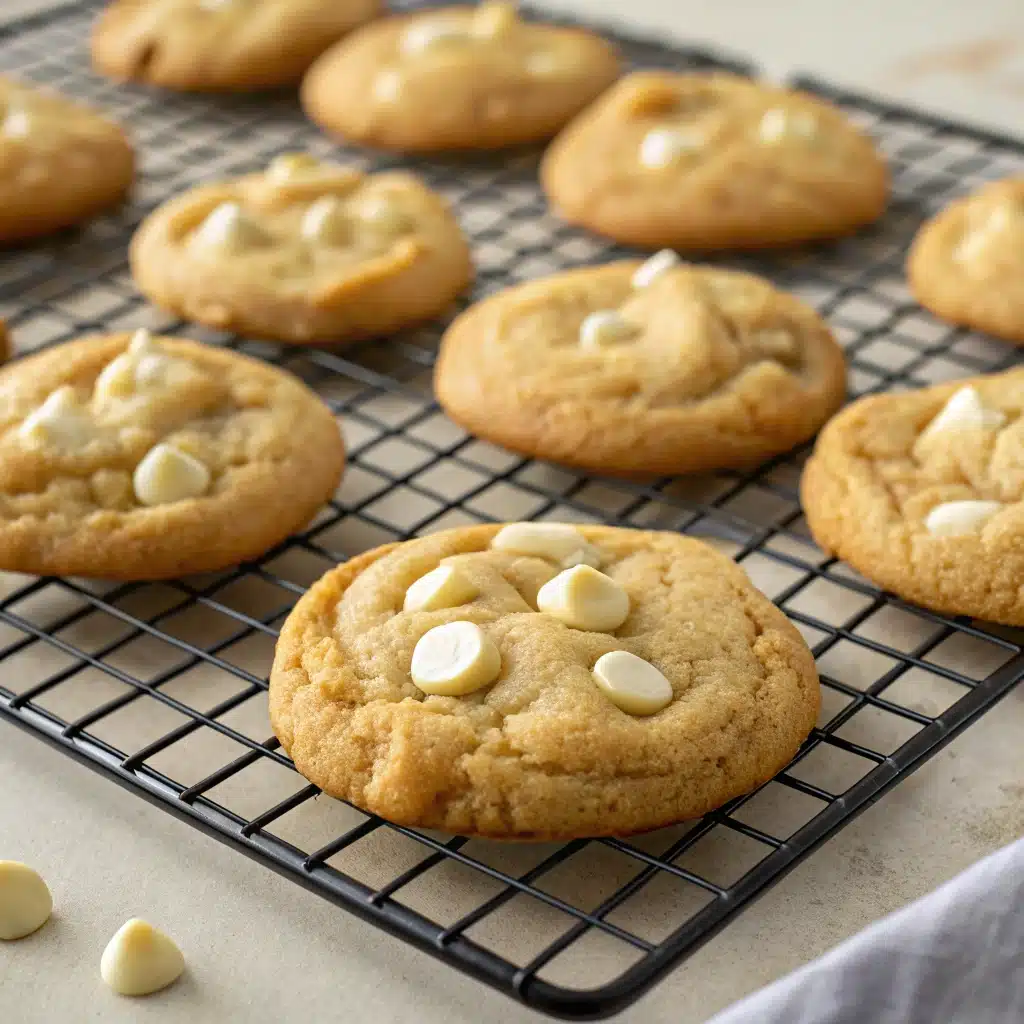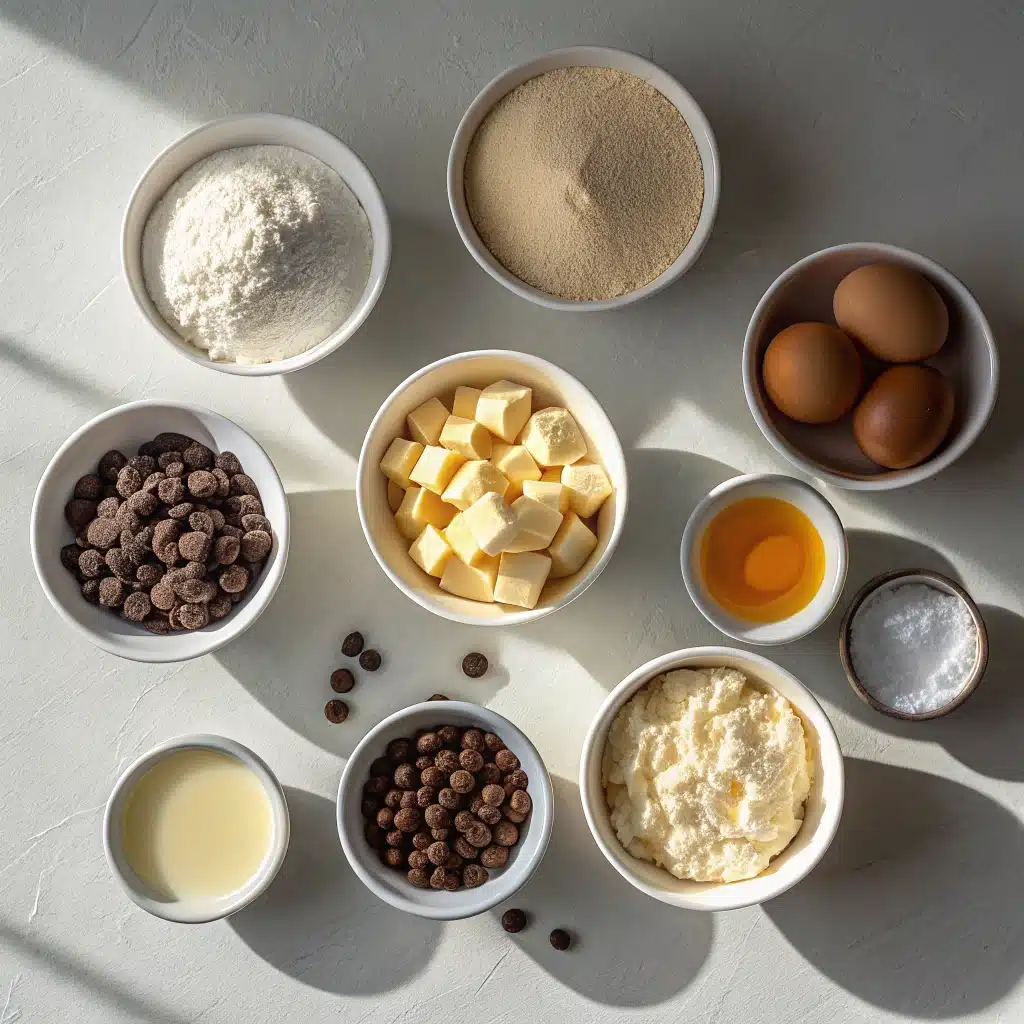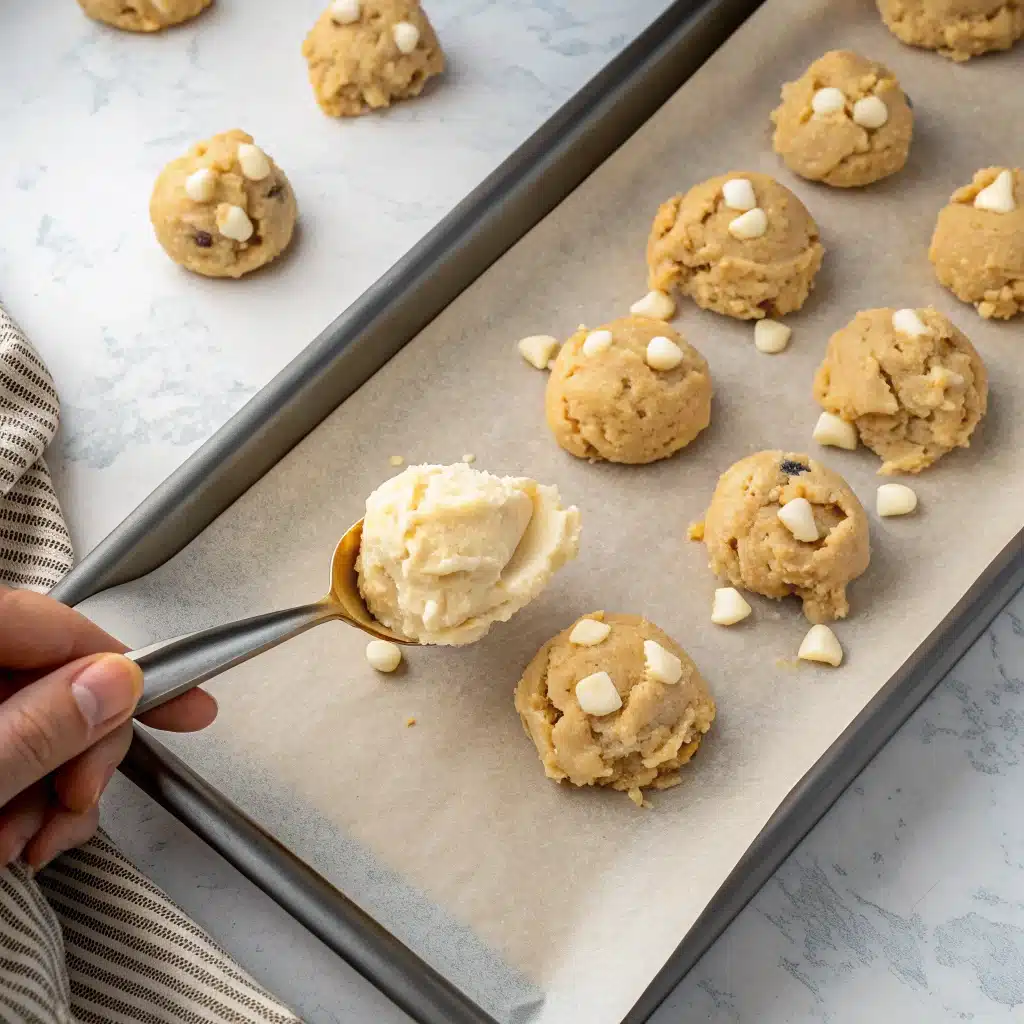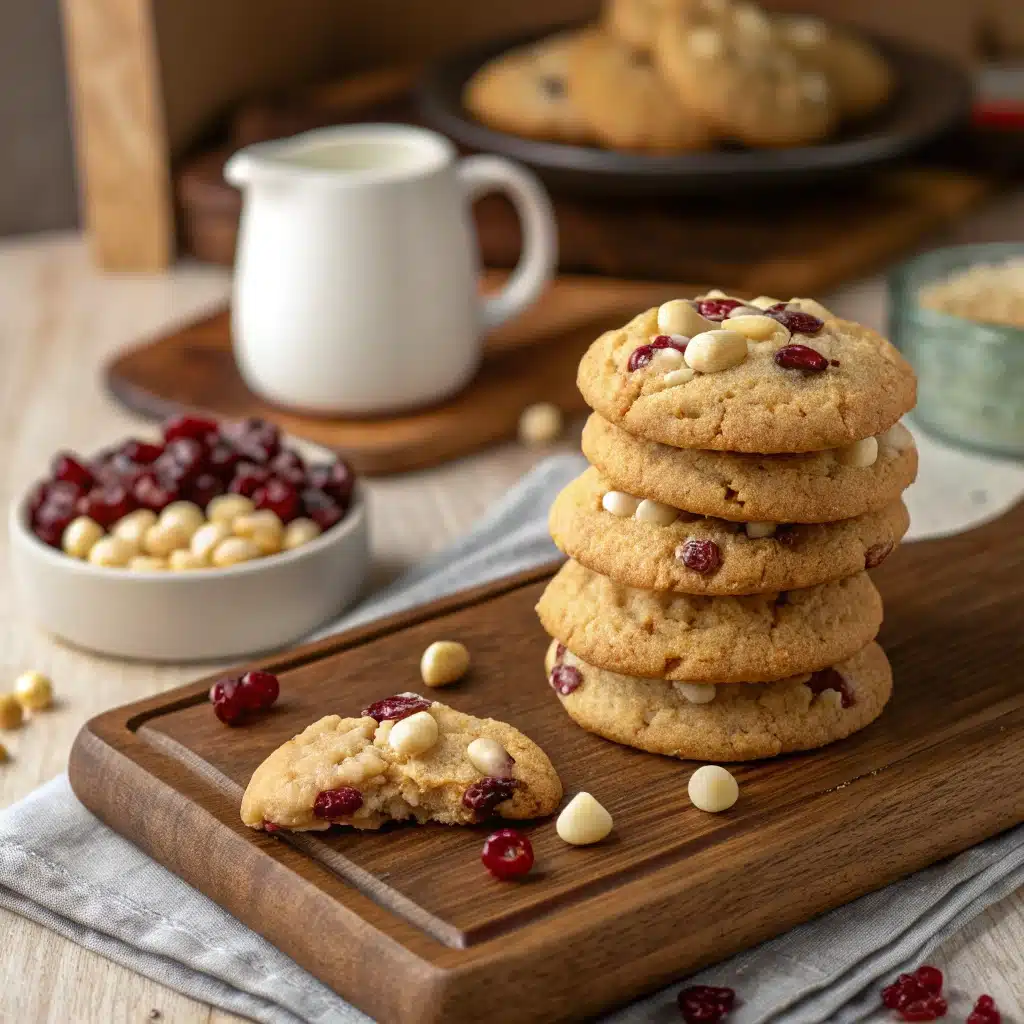White chocolate chip cookies are one of the most irresistible treats you can bake at home. Soft, chewy, and packed with creamy white chocolate chips, these cookies strike the perfect balance between sweetness and texture. Whether you’re new to baking or a seasoned pro, this guide will help you master the art of baking the perfect batch of white chocolate chip cookies every time.

We’ll cover everything from essential pantry ingredients and baking techniques to flavor pairings, storage tips, and fun mix-in ideas like macadamia nuts or dried cranberries. You’ll also learn why some white chocolate chip cookies don’t melt properly, how to fix baking issues, and even how to store leftover dough for future cravings.
Table of Contents
The Irresistible Charm of White Chocolate Chip Cookies
What Makes White Chocolate Chip Cookies So Special?
White chocolate chip cookies stand out because of their smooth, buttery flavor and Butter without cocoa solids offers a creamy, vanilla-forward flavor that stands out beautifully in cookie dough. These cookies are sweet but balanced—especially when paired with the slight crunch of the golden edges.
What really sets them apart is the texture. Chewy white chocolate chip cookies often use more brown sugar than white, helping to retain moisture and softness. A touch of cornstarch or chilling the dough can also create that pillowy bite we all love. And let’s be honest: watching those white chocolate chips melt just slightly into warm cookie dough? Pure magic.
These cookies are also incredibly versatile. Want to add a fruity zing? Toss in some dried cranberries. Looking for a nutty finish? Macadamias are a classic pairing. Whether you prefer soft and gooey or crisp around the edges, white chocolate chip cookies offer endless room to personalize.
Print
White Chocolate Chip Cookies
- Total Time: 25 minutes
- Yield: 24 cookies 1x
Description
Soft, chewy, and packed with creamy white chocolate chips, these cookies strike the perfect balance between sweetness and texture. A classic treat you can customize with nuts, cranberries, or even citrus zest.
Ingredients
- 2 1/4 cups all-purpose flour
- 1 tsp baking soda
- 1/2 tsp salt
- 2 tsp cornstarch (optional for softness)
- 3/4 cup unsalted butter, softened
- 3/4 cup brown sugar
- 1/2 cup granulated sugar
- 2 large eggs
- 2 tsp vanilla extract
- 2 cups white chocolate chips or chopped white chocolate
- Optional: 1/2 cup macadamia nuts, dried cranberries, or other mix-ins
Instructions
- Preheat oven to 350°F (175°C). Line baking sheets with parchment paper.
- In a medium bowl, whisk together flour, baking soda, salt, and cornstarch.
- In a large bowl, cream together butter, brown sugar, and granulated sugar until light and fluffy (about 2–3 minutes).
- Add eggs and vanilla extract. Mix until combined.
- Gradually add dry ingredients to the wet mixture. Mix on low speed until just combined.
- Fold in white chocolate chips and optional mix-ins.
- Chill dough for at least 30 minutes for thicker cookies.
- Scoop dough onto prepared baking sheets, spacing about 2 inches apart.
- Bake for 9–11 minutes, or until edges are lightly golden and centers look slightly underbaked.
- Let cookies cool on the baking sheet for 5 minutes before transferring to a wire rack.
Notes
For gooier cookies, use chopped white chocolate bars instead of chips. Add flaky sea salt on top before baking for a gourmet touch.
- Prep Time: 15 minutes
- Cook Time: 10 minutes
- Category: Dessert
- Method: Baking
- Cuisine: American
Nutrition
- Serving Size: 1 cookie
- Calories: 220
- Sugar: 18g
- Sodium: 140mg
- Fat: 11g
- Saturated Fat: 6g
- Unsaturated Fat: 4g
- Trans Fat: 0g
- Carbohydrates: 28g
- Fiber: 0.5g
- Protein: 2g
- Cholesterol: 25mg
The History Behind White Chocolate in Baking
White chocolate has been around since the 1930s when it was introduced by Nestlé. Originally created to utilize excess cocoa butter, it soon became a baking essential due to its distinctive flavor and smooth, creamy texturel. By the 1980s, bakers began combining it with nuts—especially macadamias—to create what’s now one of the most beloved cookie types in America.
Over time, white chocolate chip cookies evolved beyond the bakery shelf. Home bakers embraced them for their elegant look and comforting sweetness. Today, they’re a favorite for everything from holiday cookie swaps to birthday treat bags—and with good reason.
So when you whip up a batch, you’re joining a baking tradition rooted in both innovation and indulgence.
For more unique ideas, check out cranberry pistachio shortbread cookies—a great complement to your cookie tray.
Ingredients

Choosing the Right Type of White Chocolate
Not all white chocolate is created equal—and when it comes to baking the perfect white chocolate chip cookies, your choice matters. White chocolate must contain a minimum of 20% cocoa butter, rather than just sugar and milk solids. High-quality white chocolate chips or chunks will melt more smoothly and add that luscious, creamy texture to every bite.
Here’s a quick comparison table for types of white chocolate you can use:
| Type | Cocoa Butter Content | Best For | Melting Ability |
|---|---|---|---|
| Baking White Chocolate | 30–35% | Soft cookies, chunk-style | High |
| Candy Melts | 0% | Decoration only | Low |
| White Chocolate Chips | 20–30% | Most cookie recipes | Moderate |
| Couverture White Chocolate | 35%+ | Gourmet-style baking | Excellent |
Pro Tip: If you prefer gooey centers and pockets of melted chocolate, go for white chocolate bars chopped into chunks rather than chips. Chips often contain stabilizers that keep them from melting fully.
Essential Pantry Staples: Flour, Sugar, Eggs & More
While white chocolate takes the spotlight, the base of white chocolate chip cookies is equally important. Let’s break down the key ingredients you should always have on hand:
- All-Purpose Flour: Provides structure. Measure it correctly—too much flour leads to cakey cookies.
- Brown Sugar: Adds moisture and gives cookies their chewy texture.
- Granulated Sugar: Adds crisp edges and balances the sweetness of brown sugar.
- Butter: Always use unsalted butter, and make sure it’s at room temperature. This helps with even mixing and spreading.
- Eggs: Bind the ingredients and add richness.
- Vanilla Extract: Enhances the flavor of the white chocolate.
- Baking Soda: A leavening agent that gives the cookies just enough lift.
- Salt: Balances the overall sweetness.
Adding a spoonful of cornstarch is a secret many bakers use to keep cookies soft and thick. Also, chilling the dough for at least 30 minutes can prevent overspreading and deepen flavor.
Discover great add-ons like condensed milk cookies if you want a creamy twist in your cookie experiments.
Step-by-Step Guide to Making White Chocolate Chip Cookies

Preparing Your Ingredients Correctly
Before you start mixing, prepping your ingredients is key to creating soft and chewy white chocolate chip cookies. Room temperature ingredients blend more smoothly, resulting in even-textured dough.
Here’s how to prep like a pro:
- Soften the butter: Leave it out for 30–45 minutes or microwave in 5-second bursts. It should dent easily when pressed, not melt.
- Measure flour accurately: Use the spoon-and-level method to avoid packing in too much.
- Crack eggs into a bowl first: This helps prevent shells from getting into your batter.
- Chop white chocolate chunks (if using bars): Aim for uneven sizes so some pieces melt while others stay whole for pockets of gooey sweetness.
- Line your baking sheets: For even baking and effortless cleanup, use parchment paper or silicone mats.
Missteps at this stage—like cold butter or overpacked flour—can lead to dense or dry cookies.
Mixing, Scooping, and Baking Like a Pro
Once your ingredients are ready, it’s time to mix and bake your white chocolate chip cookies with precision. Follow this proven method for results that rival your favorite bakery:
Step-by-Step Process:
- Cream butter and sugars: Beat on medium speed until fluffy and pale (2–3 minutes). This step builds your cookie structure.
- Add eggs and vanilla: Mix just until incorporated. Overmixing can create a cakey texture.
- Combine dry ingredients: In a separate bowl, whisk flour, baking soda, salt, and optional cornstarch.
- Slowly mix dry into wet: Use low speed or a spatula to avoid overmixing.
- Fold in white chocolate chips: Ensure they are evenly distributed without crushing.
- Chill the dough (optional but recommended): Refrigerate for 30–60 minutes for thicker cookies with deeper flavor.
- Scoop onto baking sheet: Use a cookie scoop or tablespoon. Space 2 inches apart.
- Bake at 350°F (175°C): Bake for 9–11 minutes. The edges should be lightly golden; the centers may look underbaked—that’s perfect!
- Cool on the pan: Let cookies sit for 5 minutes before transferring to a wire rack.
Quick Tips:
- For extra melty pockets, press a few white chocolate chips into the tops before baking.
- Want perfectly round cookies? Gently swirl them with a circular cookie cutter while warm.
Looking for inspiration? Try lemon lavender cookies for a floral twist that pairs well with white chocolate.
Secret Baking Tips for Soft and Chewy Texture
Temperature Control and Resting Time
If your goal is irresistibly soft and chewy white chocolate chip cookies, then temperature is your best friend in the kitchen. It affects everything from how the dough spreads to the texture and flavor.
Why temperature matters:
- Room temperature butter creates the ideal creamy base for creaming with sugar, trapping air for lift.
- Chilled dough prevents over-spreading and helps control browning, giving you thick, bakery-style cookies.
Chilling tips:
- Chill the dough for a minimum of 30 minutes, though refrigerating it overnight enhances both flavor and texture.
- Scoop the dough before chilling to save time and effort when baking later.
Resting time post-bake is also crucial. Let cookies cool on the baking sheet for about 5 minutes after removing them from the oven. This allows them to set without drying out.
The Magic of Brown Sugar and Cornstarch
Two secret ingredients can take your white chocolate chip cookies from basic to phenomenal: brown sugar and cornstarch.
- Brown sugar adds moisture and contains molasses, which imparts a subtle caramel flavor and a chewy texture to cookies.
- For an extra chewy texture, use a 3:1 ratio of brown sugar to white sugar.
- Cornstarch, added in small amounts (1–2 teaspoons), softens the texture and helps cookies stay thick without becoming dry or crumbly.
Bonus tip: Adding a pinch of flaky sea salt on top of the cookies before baking creates a gourmet contrast that enhances the sweetness of the white chocolate.
Here’s a quick look at the difference:
| Ingredient | Function in Cookies | Impact on Texture |
|---|---|---|
| Brown Sugar | Adds moisture, caramel flavor | Chewy, soft texture |
| White Sugar | Helps browning, crisp edges | Light crunch |
| Cornstarch | Tenderizes dough | Soft, thick consistency |
| Vanilla Extract | Boosts flavor | Rounds out sweetness |
Don’t miss our flavor-packed labubu ice cream cake for an adventurous pairing with your cookie creations.
Flavor Pairings and Creative Variations

What Goes Well with White Chocolate in Cookies?
One of the best things about white chocolate chip cookies is how well they pair with a variety of flavors. White chocolate’s creamy sweetness is the perfect base for tart, nutty, or even spicy mix-ins that enhance each bite.
Here are top flavor pairings that complement white chocolate beautifully:
- Macadamia Nuts: Buttery and rich, they add crunch and elegance.
- Dried Cranberries: A popular holiday pairing, their tartness cuts the sweetness of white chocolate perfectly.
- Pistachios: Slightly salty and earthy, pistachios bring color and balance.
- Lemon Zest: Bright citrus notes add freshness and complexity.
- Raspberries or Blueberries: Add fruitiness and visual appeal—especially in summer-themed cookies.
- Coconut Flakes: Chewy, tropical, and unexpectedly perfect with white chocolate.
- Matcha Powder: Adds a bold, green tea flavor that contrasts well with the sweetness of white chocolate.
Here’s a quick pairing chart:
| Ingredient | Flavor Profile | Pairing Benefit |
|---|---|---|
| Macadamia Nuts | Buttery, crunchy | Classic combo, rich texture |
| Dried Cranberries | Tart, chewy | Cuts through sweetness |
| Lemon Zest | Bright, citrusy | Enhances freshness |
| Coconut | Sweet, tropical | Boosts chewiness and aroma |
| Matcha | Earthy, slightly bitter | Unique twist, balances sweetness |
Popular Mix-Ins: Macadamia Nuts, Cranberries, and More
If you want to elevate your white chocolate chip cookies, mix-ins are the way to go. They don’t just change the flavor; they add texture, depth, and often a fun pop of color.
Creative ideas to try:
- White Chocolate & Macadamia: This iconic combo is a bakery favorite for a reason.
- Cranberry White Chocolate Cookies: Perfect for winter and holidays.
- White Chocolate & Orange Zest: Refreshing and bright—great for spring!
- White Chocolate Toffee Cookies: Sweet and crunchy with caramel undertones.
- Peppermint White Chocolate Cookies: Ideal for festive occasions like Christmas.
- Pumpkin Spice & White Chocolate: Cozy and comforting for fall baking.
Looking for a delicate alternative? Try apple jack cereal cookies for a nostalgic crunch that also pairs well with white chocolate.
Pro Tip: Always fold in your mix-ins gently to keep the dough evenly textured and prevent the chips or nuts from breaking apart.
Storage, Freezing, and Reheating Tips
How to Keep White Chocolate Chip Cookies Fresh Longer
Baking the perfect batch of white chocolate chip cookies is only half the job—knowing how to store them ensures every bite stays as delicious as the first. These cookies, with their creamy chunks and soft centers, can easily lose texture if stored improperly.
Here’s how to keep white chocolate chip cookies fresh and soft:
- Use an airtight container: Store your cookies in a sealed container at room temperature. This prevents air exposure, which leads to drying.
- Layer with parchment paper: If stacking your cookies, separate layers with parchment to avoid sticking or breaking.
- Add a slice of bread: Including a slice of plain white bread in your container helps maintain moisture. The cookies absorb humidity from the bread, keeping them soft for days.
- Shelf life: When properly stored, your white chocolate chip cookies will stay soft and chewy for up to 5–7 days.
Only refrigerate cookies when absolutely necessary to maintain their texture and freshness. Refrigeration often makes them stale or rubbery due to temperature changes.
Looking to enjoy fresh cookies on-demand? Let’s freeze them the right way.
Best Methods to Freeze Dough and Baked White Chocolate Chip Cookies
Freezing your white chocolate chip cookies is a smart move for batch baking, holiday prep, or making treats ahead of time. You can freeze both the raw dough and fully baked cookies with excellent results.
How to Freeze Cookie Dough:
- Scoop dough balls onto a parchment-lined baking tray.
- Freeze for 1–2 hours until firm.
- Place the dough balls in a labeled zip-top bag and store them for up to 3 months.
- When ready to bake, pop the frozen dough straight into the oven—just add 1–2 extra minutes to your normal baking time.
Freezing the dough preserves freshness and texture, giving you warm white chocolate chip cookies anytime you like.
How to Freeze Baked Cookies:
Already baked a batch of white chocolate chip cookies and want to save some?
- Let them cool completely before wrapping.
- Wrap each cookie in foil or plastic wrap.
- Store in a freezer-safe container or bag.
- Cookies stay delicious for up to 2 months in the freezer.
To enjoy them later, thaw at room temperature or microwave for 10–15 seconds for a warm, gooey center.
How to Reheat White Chocolate Chip Cookies Perfectly:
Want to revive the just-baked magic? Here’s how to reheat your cookies without drying them out:
- Microwave: Wrap a single cookie in a damp paper towel and microwave for 10–12 seconds to revive its softness.
- Oven: Preheat to 300°F, place cookies on a tray, and warm for 4–5 minutes. This method crisps the edges while keeping the center soft—ideal for chewy white chocolate chip cookies.
Cookies that are stored and reheated well still offer that perfect bite: golden edges, creamy white chocolate, and soft middles.
Discover great storage-friendly sweets like our condensed milk cookies—a rich and chewy treat that pairs well with white chocolate.
Troubleshooting Common Baking Issues
Why Didn’t My White Chocolate Chips Melt?
One of the most common questions about white chocolate chip cookies is: “Why don’t the chips melt like regular chocolate?” The short answer? It’s all about stabilizers.
Most store-bought white chocolate chips are designed to hold their shape during baking. Manufacturers add palm oil or stabilizers so they don’t melt into puddles, especially in cookies where shape matters. While this preserves a nice look, it can affect the gooey factor that many bakers love.
Fix it like this:
- Use chopped white chocolate bars instead of chips. Bars have higher cocoa butter content and fewer stabilizers.
- Choose high-quality chips with cocoa butter listed as the first ingredient.
- Press a few extra chips on top before baking to get that melty look on the surface.
Fixing Flat, Overbaked, or Dry Cookies
Your white chocolate chip cookies came out too flat or too dry? Don’t worry—this is super common, and usually easy to fix. Here’s what went wrong and how to prevent it:
Flat Cookies:
Problem: Too much butter, warm dough, or overmixed batter.
Fix:
- Chill your dough for 30–60 minutes before baking.
- Avoid greasing the pan—use parchment paper instead.
- Don’t overbeat the butter and sugar—3 minutes max.
Overbaked or Dry Cookies:
Problem: Baking too long, incorrect oven temp, or too much flour.
Fix:
- Slightly underbake: Remove cookies when edges are golden but centers are soft.
- Calibrate your oven with an external thermometer.
- Spoon and level your flour—don’t scoop directly from the bag.
Cookies Spread Too Much:
Problem: Dough too warm or too little flour.
Fix:
- Always chill the dough before baking.
- Add 1 extra tablespoon of flour per cup if dough feels sticky.
Pro Tip: Want consistent results? Bake one test cookie first before placing a full tray in the oven. This saves you from overbaking a whole batch of white chocolate chip cookies.
Looking for another indulgent fix? Try chocolate chip shortbread for a dense, no-fail alternative when texture is key.
Nutritional Insights and Dietary Alternatives
Gluten-Free, Vegan, or Keto Options
White chocolate chip cookies may be deliciously indulgent, but that doesn’t mean they’re off-limits for everyone. With a few smart swaps, you can enjoy this classic treat while accommodating dietary needs—whether you’re avoiding gluten, dairy, or carbs.
Gluten-Free White Chocolate Chip Cookies
Going gluten-free doesn’t mean giving up chewy, sweet cookies. Just replace all-purpose flour with a 1:1 gluten-free baking blend that includes xanthan gum for structure.
Tips for success:
- Let the dough rest for 30 minutes after mixing—this hydrates the flour and improves texture.
- Avoid gritty blends; opt for almond flour or rice flour-based mixes.
Vegan White Chocolate Chip Cookies
Standard white chocolate chips contain milk solids, so to make vegan cookies, you’ll need dairy-free white chocolate (available at specialty stores or online). Also, swap out animal-based ingredients like butter and eggs.
Easy swaps:
- Butter → vegan butter or coconut oil
- Eggs → 1 tbsp ground flax + 3 tbsp water (per egg)
- Milk chocolate → dairy-free white chocolate chunks
These swaps result in vegan white chocolate chip cookies that are just as satisfying and rich as the original version.
Low-Carb or Keto-Friendly Version
Though traditional white chocolate chip cookies are high in sugar and carbs, keto bakers can still enjoy them using almond flour and sugar-free chocolate.
Ingredients to use:
- Almond flour or coconut flour (low in carbs)
- Erythritol or monk fruit sweetener
- Sugar-free white chocolate chips (available in keto baking aisles)
The texture will be slightly different—more dense than chewy—but still tasty and perfect for a low-carb lifestyle.
Nutrition Breakdown Per Cookie
Here’s a general estimate of what you can expect in a traditional, bakery-style white chocolate chip cookie (serving size: 1 cookie):
| Nutrient | Approximate Value |
|---|---|
| Calories | 200–230 kcal |
| Total Fat | 10–12g |
| Saturated Fat | 6g |
| Sugar | 16–20g |
| Protein | 2g |
| Carbohydrates | 25–30g |
| Fiber | 0.5–1g |
Note: These values vary depending on ingredients and portion sizes.
If you’re tracking macros or baking for health-conscious friends, consider making mini white chocolate chip cookies with reduced sugar or smaller portions to stay snack-friendly.
Conclusion
White chocolate chip cookies are more than just a twist on a classic—they’re a celebration of soft textures, creamy flavors, and endless creativity. Whether you’re baking them chewy with macadamia nuts, packing them with cranberries, or making gluten-free and vegan alternatives, these cookies are a crowd-pleasing favorite with room for personal flair.
From the right baking techniques to smart storage and flavorful add-ins, mastering white chocolate chip cookies doesn’t require professional skills—just the right tips, a bit of patience, and a love for indulgent bites.
Looking for more sweet inspiration?
Don’t miss our comforting apple jack cereal cookies or explore the rich layers in our labubu ice cream cake—a perfect complement to your cookie cravings.
Fore more recipes follow me in Facebook, medium and Pinterest
FAQs
How to Know When Chocolate Chip Cookies Are Done?
You’ll know your white chocolate chip cookies are done when the edges are lightly golden, but the centers still look slightly underbaked. That’s the key to achieving a soft and chewy texture. The cookies will continue to firm up as they cool on the pan. Overbaking can lead to dryness, so trust the timing and appearance more than the firmness.
Pro tip: Set a timer for 9–11 minutes, and don’t wait for the whole cookie to look brown—just check that the edges are set and the middle has puffed slightly.
Do White Chocolate Chips Not Melt in Cookies?
It’s true—many white chocolate chips don’t melt fully during baking. That’s because they contain stabilizers and milk solids designed to help them retain shape. This is helpful for aesthetic purposes but can leave you wondering where the gooey texture went.
To get that melty finish, use chopped white chocolate bars or premium chips with a higher cocoa butter content. Also, pressing a few extra chips on top of each cookie before baking can help them soften more visibly.
Will Chocolate Chips Melt in Cookies?
Yes, but it depends on the type of chocolate used. Semi-sweet, dark, or milk chocolate chips generally soften during baking but hold their shape unless stirred while hot. White chocolate chips are more resistant to melting unless they’re made with real cocoa butter and fewer stabilizers.
If you’re after ultra-gooey cookies, go with chopped white chocolate or couverture chocolate, which melts more easily into luscious ribbons throughout the dough.
Bonus tip: For cookies that look and taste bakery-fresh, place 2–3 chocolate chips or chunks on top right before baking.
Don’t miss our favorite cranberry pistachio shortbread cookies for more melt-in-your-mouth dessert inspiration.




